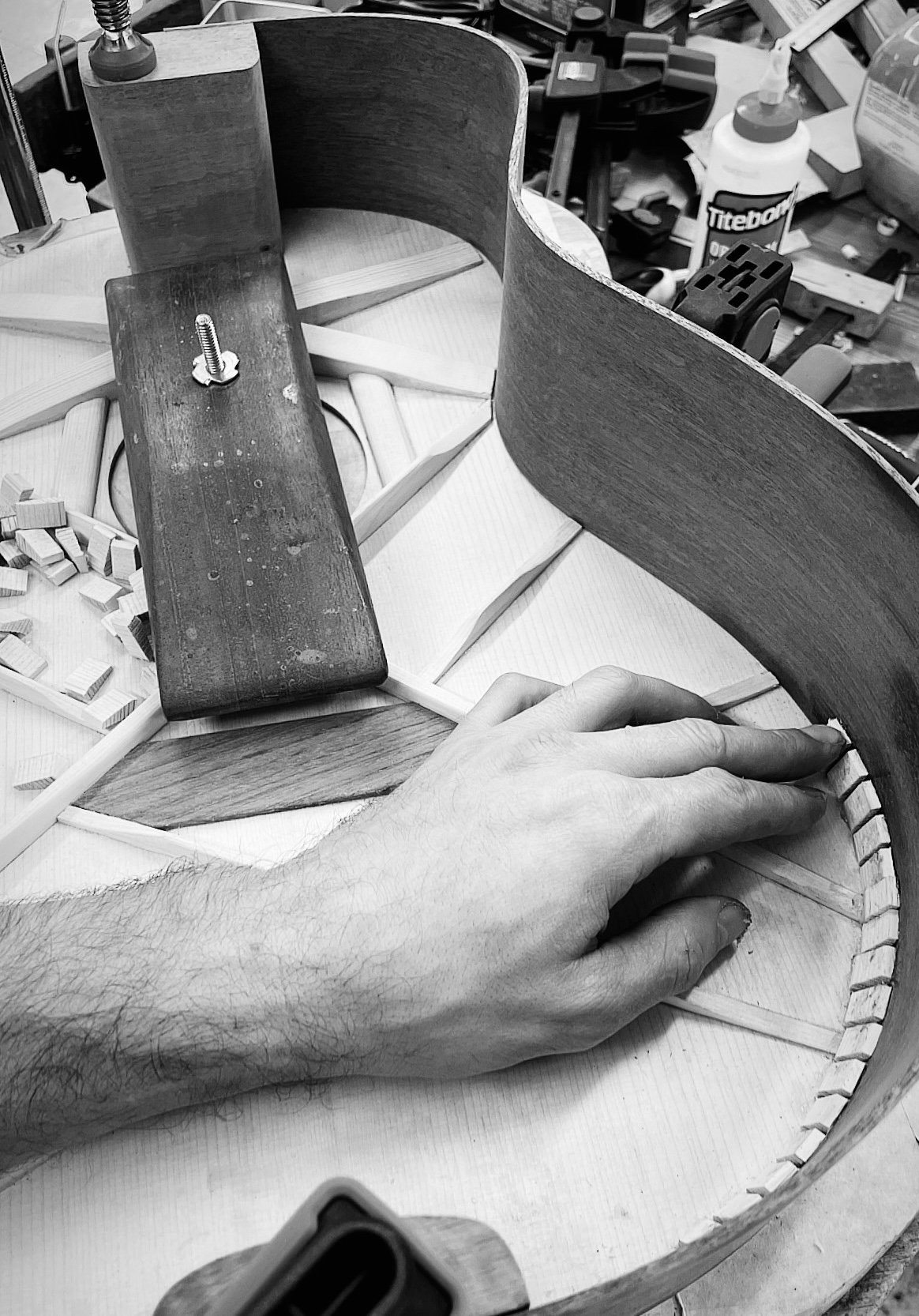Philosophy
FLATTOP
INSPIRATION
Around 2016 I got the chance to play a few instruments made by California luthier Bruce Sexauer. One of the first was a 12-fret 0 with a cutaway made from Brazilian Rosewood that changed my ears forever. I didn’t know a small bodied guitar could sound that glorious. I ruminated as it sat in my lap. It became clear to me that I no longer wanted to build in the modern style I had been using. I wanted to build an instrument like this single 0. It was an instrument that resonated from the entire length of the guitar, where you could feel vibrations from every surface you touched, and enjoy a balanced range on the sonic spectrum.
I was able to meet Bruce shortly after and tell him how much I loved the guitar and he was gracious to answer my questions. He informed me that his building journal was available online at the Acoustic Guitar Forum. He is quite prolific in his journaling. Studying his records and experimenting on my own have guided me to an intuitive/traditional approach towards building my flattops.
MOLDLESS ASSEMBLY
I glue my tops to the sides using a top-down assembly method. The top is clamped to custom radius’d dish that is similar to a Solera used in classical guitar building. I then glue the end blocks to the top and then the ends of the sides to the blocks.
Using my fingers and hot hide glue, I glue tiny triangular spruce blocks called peones or tentellones to attach the sides to the top. It takes a lot longer than glueing the readily available “kerfing”, which I use to attach the sides to the back. Despite it taking much longer, I do it because I believe this creates little to no stress on the wood as its being glued and results in a “broken in” sound out of a new guitar.
SIDE REINFORCEMENT
In contrast to a modern approach, which is to make the sides rigid as possible in order to deflect vibrations back into the top, my aim is to not. Which is to say, I want the sides of my guitar to also vibrate. I use a solid wood side instead of a laminated side and I do not use side reinforcement braces. I glue fabric ribbon strips on the side. Their purpose is to prevent the spread of a crack should one appear from abuse. The result of this approach yields a lighter guitar and a vibrational experience throughout the entirety of the guitars box.
TRADITIONAL PERSPECTIVE
I had a conversation with my friend, owner and head brewer at Tonewood Brewing, Eli Facchinei. I complimented him on how great all of his brews were and how I thought each one, thought different, were “approachable”. Nothing too far out of the ballpark and no “novelty” beers as he put it. He stays within the lines and focus’ on execution and strives for perfection. We share the same focus in our crafts.
I do appreciate progress, innovation, and reinvention. It is my belief, however, that these “advancements” must serve the musician and their needs for the music they create. Otherwise, it is self indulgence and not something I’m interested in building.
I view the guitar as a traditional instrument for traditional music. I believe rock n’ roll, blues, jazz, bluegrass, folk, soul, etc… to now be traditional art forms with the needs of the guitar player being mostly served by the designs of the past, and, that it is my job to create the very best examples of said instruments.
ARCHTOP
INSPIRATION
My tastes, whether biased or not, are the sound of my mentor Bill Comins’ guitars: thick and rounded trebles, punchy but balanced and controlled lows/mids, with even and consistent tone up and down the fretboard. .
PARAMETERS
When I consider the jazz archtop as a usable instrument for musicians, I find there to be a very specific and narrow scope in its capabilities and intent. Often, the question is posed as to if it is an acoustic or electric instrument. Ultimately, I prefer a “toe the line” approach to constructing the instrument, but have the sounds of electric jazz players of the 1950’s-1970’s in my head.
Through the years I’ve spent with Bill and servicing jazz musicians in repair, I’ve learned and gained valuable insight on the different methods, both in construction, and after assembly, used to hone in on specific sounds and feel.




